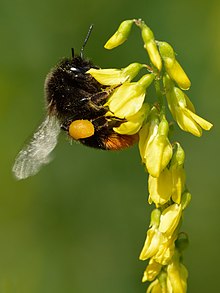| Melilotus | |
|---|---|

| |
| Melilotus officinalis | |
| Scientific classification | |
| Kingdom: | Plantae |
| Clade: | Tracheophytes |
| Clade: | Angiosperms |
| Clade: | Eudicots |
| Clade: | Rosids |
| Order: | Fabales |
| Family: | Fabaceae |
| Subfamily: | Faboideae |
| Tribe: | Trifolieae |
| Genus: | Melilotus Mill.[1] |
| Type species | |
| Melilotus officinalis (L.) Lam.
| |
| Species | |
|
See text | |
| Synonyms | |
|
Brachylobus Dulac (1867)[2] | |

Melilotus, known as melilot, sweet clover, and kumoniga (from the Cumans),[3] is a genus in the family Fabaceae (the same family that also includes the Trifolium clovers). Members are known as common grassland plants and as weeds of cultivated ground. Originally from Europe and Asia, it is now found worldwide.
This legume is commonly named for its sweet smell, which is due to the presence of coumarin in its tissues. Coumarin, though responsible for the sweet smell of hay and newly mowed grass, has a bitter taste, and, as such, possibly acts as a means for the plant to discourage consumption by animals.[4] Fungi (including Penicillium, Aspergillus, Fusarium, and Mucor[5]) can convert coumarin into dicoumarol, a toxic anticoagulant. Consequently, dicoumarol may be found in decaying sweet-clover, and was the cause of the so-called sweet-clover disease, recognized in cattle in the 1920s.[6] A few varieties of sweet clover have been developed with low coumarin content and are safer for forage and silage.[7]
The name sweet clover varies orthographically (sweet-clover, sweetclover).
- ^ "Melilotus Mill. | Plants of the World Online | Kew Science". Plants of the World Online. Retrieved 2020-06-28.
- ^ a b c d e Woodgate, Katherine; Maxted, Nigel; Bennett, Sarita Jane (1996). Bennett, Sarita Jane; Cocks, Philip Stanley (eds.). Genetic resources of Mediterranean pasture and forage legumes. Current Plant Science and Biotechnology in Agriculture. Vol. 33. Norwell, MA: Kluwer Academic Publishers. p. 203. ISBN 978-0-7923-5522-9.
- ^ Bulgarian Folk Customs, Mercia MacDermott, pg 27
- ^ "Phytochemicals.info:Coumarin". Archived from the original on September 27, 2006. Retrieved 26 November 2011.
{{cite web}}: CS1 maint: unfit URL (link) - ^ Edwards WC, Burrows GE, Tyr RJ: 1984, Toxic plants of Oklahoma:clovers. Okla Vet Med Assoc 36:30-32.
- ^ Behzad Yamini; Robert H. Poppenga; W. Emmett Braselton Jr.; Lawrence J. Judge (1995). "Dicoumarol (moldy sweet clover) toxicosis in a group of Holstein calves". J Vet Diagn Invest. 7 (3): 420–422. doi:10.1177/104063879500700328. PMID 7578469.
- ^ Christina Curell (July 2, 2013). "Sweet clovers: What is the difference between yellow sweet clover and white sweet clover?". Michigan State University. Retrieved 17 May 2017.